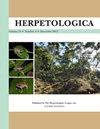Tourism Value of Crocodilians: The Black Caiman (Melanosuchus niger) as a Case Study
IF 1.1
3区 生物学
Q2 ZOOLOGY
引用次数: 2
Abstract
Abstract: Wildlife tourism, including tourism involving large predators, is a rapidly growing industry that can generate many conservation and economic benefits. Monetary values can be derived for populations of large predators, and even individuals, on the basis of how much money tourists spend to see and interact with these awe-inspiring animals, but valuation studies only exist for a few groups of species. To help fill this gap we quantified the monetary value of crocodilians that are the focus of a wildlife tourism business in South America, the first time such a value has been calculated for crocodilians. We also compared the monetary values we derived with the monetary values of other crocodilians harvested in the hunting and farming industries during the same time period (2009–2014). We found mean minimum and maximum gross values of individual crocodilians per year as part of wildlife tourism were $422.00 USD and $566.67 USD, respectively, both higher than the mean gross value of individual crocodilians per year across hunting and farming industries ($300.29 USD). Individual crocodilians that were recaptured multiple times as part of wildlife tourism activities reached a peak value of $2700.00 USD. Thus, our study demonstrates that wildlife tourism can create substantial monetary incentives for local communities that coexist with crocodilians to work toward conservation goals. We conclude that wildlife tourism focused on crocodilians should be viewed as part of a larger strategy for conserving threatened populations, one that may include partners in the farming and hunting industries as well.鳄鱼的旅游价值——以黑凯曼为例
摘要:野生动物旅游,包括大型食肉动物旅游,是一个快速发展的行业,可以产生许多保护和经济效益。根据游客观看这些令人敬畏的动物并与之互动的花费,可以得出大型食肉动物种群甚至个体的货币价值,但估价研究只针对少数物种群体。为了填补这一空白,我们量化了南美洲野生动物旅游业务重点鳄鱼的货币价值,这是首次为鳄鱼计算出这样的价值。我们还将我们得出的货币价值与同期(2009-2014年)在狩猎和农业中收获的其他鳄鱼的货币价值进行了比较。我们发现,作为野生动物旅游的一部分,鳄鱼个体每年的平均最低和最高总值分别为422.00美元和566.67美元,均高于狩猎和农业中鳄鱼个体每年平均总值(300.29美元)。作为野生动物旅游活动的一部分,多次被捕获的鳄鱼个体达到了2700.00美元的峰值。因此,我们的研究表明,野生动物旅游可以为与鳄鱼共存的当地社区创造大量的货币激励,以实现保护目标。我们的结论是,以鳄鱼为重点的野生动物旅游应该被视为保护受威胁种群的更大战略的一部分,其中可能包括农业和狩猎业的合作伙伴。
本文章由计算机程序翻译,如有差异,请以英文原文为准。
求助全文
约1分钟内获得全文
求助全文
来源期刊

Herpetologica
生物-动物学
CiteScore
4.60
自引率
0.00%
发文量
27
审稿时长
>12 weeks
期刊介绍:
Established in 1936, Herpetologica is a quarterly peer-reviewed journal serving herpetologists, biologists, ecologists, conservationists, researchers and the scientific community. The journal contains original research papers and essays about the biology of reptiles and amphibians, and covers many relevant topics including: behavior, conservation, ecology, genetics, morphology, physiology and taxonomy.
 求助内容:
求助内容: 应助结果提醒方式:
应助结果提醒方式:


